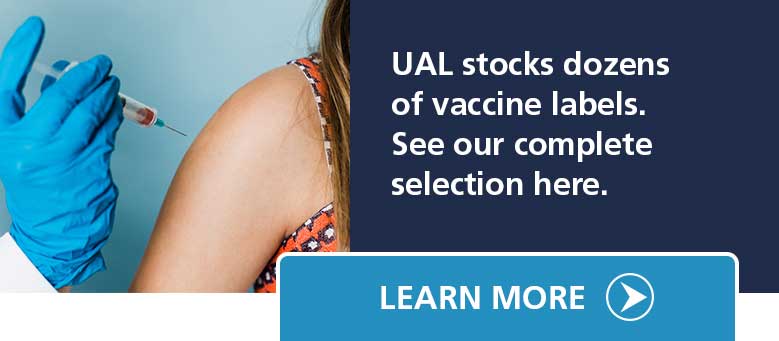Over the last 200 years, there are a few medical breakthroughs that have had an enormous impact on the life expectancy of people worldwide. From Joseph Lister who introduced the importance of hand washing and using antiseptics during surgery to Alexander Fleming who created penicillin, these two doctors' discoveries saved millions of lives. But there’s another doctor that deserves a spot on the Mount Rushmore of medical breakthroughs. That is Edward Jenner the “Father of Immunology.” He created the first vaccine against smallpox and his contributions led to other inoculations that protect us against life-threatening illnesses. But for providers, the medicine itself is only part of the process. Administering vaccines safely demands steps that support patient safety initiatives. Use this ultimate guide to vaccine labeling to ensure you meet those standards.
Why Are Vaccine Labels Important?
Vaccine labels communicate important information that helps ensure safe vaccine distribution and administration and reinforce a company’s vaccination policy.
How Are Vaccine Labels Used?
Vaccine labels serve a number of important roles. Applied to syringes and other injection devices, they enhance safe medication dispensing by clearly communicating the type of vaccine being readied for administration. In addition, vaccines typically require a temperature-controlled supply chain. Vaccine labels serve as alerts to the care team to make certain that established conditions have been maintained. Lastly, they communicate vaccination status and support a vaccination policy. Worn on employee badges, they inform others of their vaccine status and communicate the importance of vaccinations to others.
Organizations that don’t use vaccine labels face a higher risk of medication dispensing errors and vaccine spoilage.
Common Types Of Vaccines
There are six common categories of vaccines with each providing specific effectiveness against certain types of viruses and bacteria. For example:
1) Live-attenuated vaccines use a live version of the germ or virus that causes a disease in the body. For example, the vaccine for Monekypox fits into this category as do these:
- Measles, mumps, and rubella (MMR combined vaccine)
- Rotavirus
- Smallpox
- Chickenpox
- Yellow fever
2) Inactivated vaccines use a strain of a bacteria or virus that has been killed with heat or chemicals. Prevalent inactivated vaccines include:
- Hepatitis A
- Flu
3) Subunit, recombinant, conjugate, and polysaccharide vaccines use particular parts of the germ or virus and target:
- Hib (Hemophilus influenza type b)
- Hepatitis B
- Human papillomavirus (HPV)
4) Toxoid vaccines use toxins created by the bacteria or virus to create immunity to the specific parts of the bacteria or virus that cause disease. These vaccines fall into this category:
- Tetanus
- Diphtheria
5) mRNA vaccines are composed of an mRNA sequence coding for a pathogen-specific protein (antigen). When introduced into the body, the target antigen is recognized by the immune system, leading to the induction of desired immune responses. This vaccine became particularly well known because it was effective in preventing:
- COVID-19
6) Viral vector vaccines modify another virus and use it as a vector to deliver protection from the intended virus. Some of the viruses targeted with this vaccine category include:
- HIV
- Mycobacterium tuberculosis
Regardless of the category, vaccine labels help to ensure vaccines are administered safely and serve as an effective way to communicate employee vaccination policies. improve the effectiveness of the vaccine workflow, ensuring safe administration and supporting employee vaccination.
Common Types Of Vaccine Labels
There are three distinct types of vaccine labels that serve the needs of healthcare providers, ones that define the vaccine type, ensure proper handling, and communicate the vaccine status of patients and staff. Here are examples of those items.
Vaccine Syringe Labels
Applied to vials, syringes and other injection devices, vaccine syringe labels clearly communicate the vaccine type and include space to write expiration dates and time. These items help ensure the clinical staff administers the correct vaccine and that it meets proper use dates and time requirements.
Vaccine Cold Chain Labels
Many vaccines require a process that controls the temperature throughout the supply chain. Vaccine cold chain labels allow temperature monitoring from the manufacturing plant, to the transport and delivery of the vaccine and correct storage at the provider facility, and ultimately with administration of the vaccine to the patient. For example, cold chain labels allow you to detect any temperature abnormalities by detailing the exposure time, showing if it's brief (2 hours) moderate (12 hours) or prolonged (48 hrs or more).
Do Not Unplug Labels
Although cold chain labels allow you to monitor temperatures throughout the supply chain, they don’t prevent unintentional electrical outages. Cords from refrigerators where vaccines are stored before administration need warnings to ensure they remain plugged into outlets and remain at the right temperature. Do Not Unplug labels prevent an unintentional loss of electricity which could cause vaccines to spoil.
Got Flu Vaccine / Got COVID Vaccine Labels
Got Flu Vaccine / Got COVID Vaccine stickers and labels communicate vaccine compliance to patients and customers. They are easy to apply to badges and contain a laminated surface which allows them to withstand repeated wipedowns with cleansers.
United Ad Label
United Ad Label produces stock and custom vaccine labels that assist the safe administration of vaccines. Our catalog contains dozens of products designed to meet your vaccine labeling needs. Contact us to learn more.

